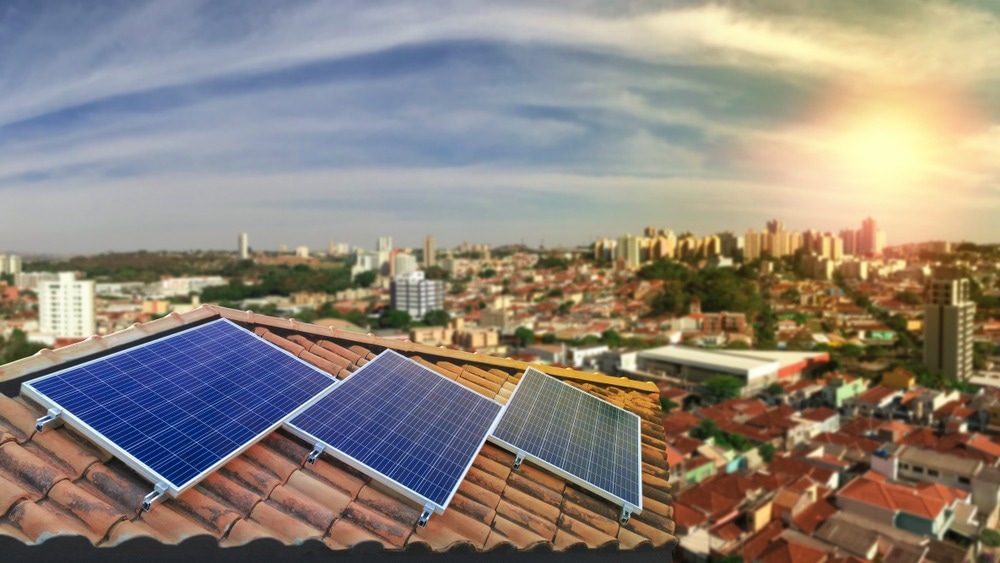In a recent paper published in Scientific Reports, researchers have proposed a photovoltaic/thermal (PV/T) system that uses a Tesla valve to enhance heat transfer and energy efficiency. They conducted a numerical simulation and analysis of the system with different flow channel structures, fluid types, and valve parameters.

Image Credit: Andre Nery/Shutterstock.com
Challenges of Photovoltaic Systems
Solar energy is one of Earth's most abundant, environmentally friendly, and renewable energy sources. Its conversion into electricity relies on solar PV cells, which generate electric current when exposed to sunlight. However, conventional PV systems suffer from low energy conversion and overheating issues. Therefore, maintaining the optimal temperature of PV cells is essential.
One strategy to address this is integrating PV cells with solar thermal collectors, which absorb solar radiation and transfer it to a fluid medium like air, water, or nanofluids. This integration results in a hybrid PV/T system that generates electricity and heat from a single solar collector. PV/T systems can enhance overall energy efficiency and utilization of solar energy while reducing the cost and environmental impact.
These systems encounter challenges, including designing and optimizing flow channel structures, selecting and optimizing fluid mediums, and regulating fluid flow. These factors significantly impact heat transfer, energy efficiency, cooling effectiveness, and PV cell electrical output.
How a Tesla Valve Could Enhance Photovoltaic/Thermal Systems
The Scientific Reports research paper introduced a novel approach to enhancing PV/T systems by integrating them with a Tesla valve, a one-way valve capable of creating pressure differences and flow resistance.
The Tesla valve comprises a series of interconnected loops or chambers with varying angles and lengths, creating vortices and turbulence in fluid flow. The integration aims to improve heat transfer and energy efficiency by enhancing fluid velocity, heat transfer coefficient, and contact area between fluid and solid surfaces.
The authors used ANSYS software to numerically simulate and analyze the Tesla valve-based PV/T system and compare it with four flow channel structures: semicircle, rectangle, triangle, and Tesla valve.
They also examined the effects of various fluid types on system performance, such as water and nanofluids, and different valve parameters, including angle, number, type, and diameter ratio. Evaluation criteria included cooling effect, electrical efficiency, thermal efficiency, and overall energy efficiency.
Reducing Temperature and Electrical Efficiency of Photovoltaic/Thermal Systems
The researchers found that the PV/T system incorporating the Tesla valve exhibited superior cooling performance and thermoelectric efficiency compared to other flow channel structures. They observed that the Tesla valve-equipped system could reduce PV cell temperature by up to 20 °C and increase electrical efficiency by up to 2.5%.
This system achieved a thermal efficiency of up to 59.65%, an electrical efficiency of 16.32%, and an overall energy efficiency of up to 76%.
The study attributed the Tesla valve's exceptional performance to the acceleration principle, which results in a higher exit velocity than inlet velocity, and the vortex principle, which enhances heat transfer and fluid mixing.
The paper underscored the potential of nanofluids, consisting of fluids with suspended nanoparticles, to enhance the system's cooling effect and energy efficiency. Nanofluids, characterized by higher thermal conductivity, density, and viscosity compared to water, were found to improve heat transfer and fluid flow characteristics.
The study compared four different fluid types: water, magnesium oxide (MgO), titanium dioxide (TiO2), and aluminum oxide (Al2O3). Al2O3 exhibited the best performance, followed by TiO2 and MgO. Furthermore, nanofluids were observed to facilitate rapid cooling and efficient heat storage within the system.
Optimal design parameters were observed for the Tesla valve, including a symmetrical valve type, a pipe diameter ratio of 1, an angle of 30°, and maximizing the number of valves.
These parameters maximized the valve's pressure drop ratio and throttling efficiency, indicating flow resistance and control. A mathematical expression was also derived to relate valve number, Reynolds number, and average PV temperature, facilitating optimization and design processes.
Applications of the PV/T Solution
The system has applications in various fields and sectors requiring electricity and heat from solar energy. These encompass residential, commercial, industrial, and agricultural domains. It offers a sustainable solution by furnishing clean and renewable energy for diverse purposes, including domestic hot water, space heating, cooling, and industrial processes.
The solution enhances energy efficiency and effectively harnesses solar energy, extending the lifespan and the performance of PV cells. The system's versatility extends beyond solar energy applications, reaching into various fields such as miniature heat dissipation systems in cell phones, aerospace, and beyond.
Conclusion
The novel system demonstrated efficacy in enhancing the heat transfer and energy efficiency of PV/T systems. Through comprehensive numerical simulations and analyses across various flow channel structures, fluid types, and valve parameters, the authors underscored the potential for further enhancement, particularly through the utilization of nanofluids and optimized design parameters.
Their contributions have advanced PV/T system development and underscored the applicability of Tesla valves in heat dissipation and energy storage.
The researchers suggested directions for future research, including conducting experimental studies to validate simulation outcomes, exploring alternative nanofluids and nanoparticles, examining factors such as solar radiation, ambient temperature, and fluid flow rate, and customizing system design and operation to suit diverse applications and scenarios.
Journal Reference
Du, S., Zou, J., Zheng, X. et al. Numerical study on solar photovoltaic/thermal system with tesla valve. Sci Rep 14, 10836 (2024). https://doi.org/10.1038/s41598-024-61785-x
Disclaimer: The views expressed here are those of the author expressed in their private capacity and do not necessarily represent the views of AZoM.com Limited T/A AZoNetwork the owner and operator of this website. This disclaimer forms part of the Terms and conditions of use of this website.